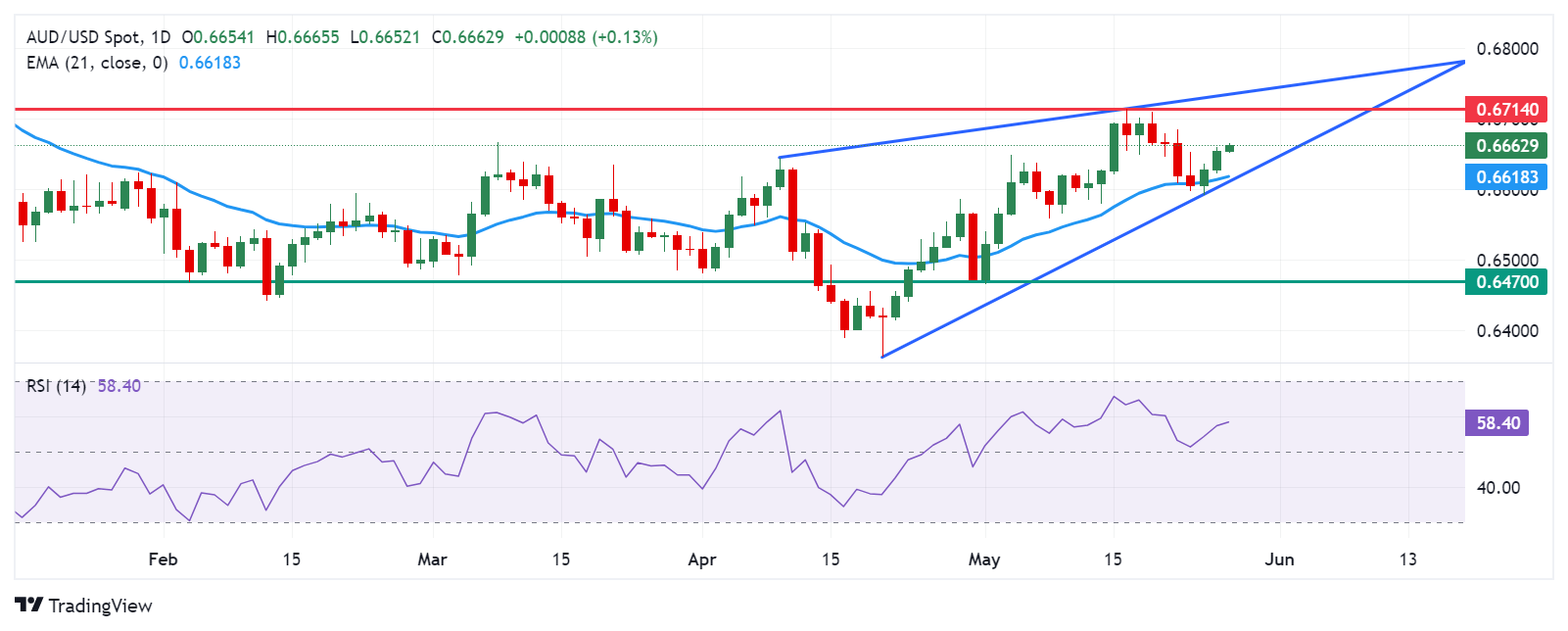- The Australian Dollar continues to gain ground due to improved risk appetite.
- Australia’s Retail Sales grew 0.1% in April, against the expected 0.2% and the previous decline of 0.4%.
- The US Dollar depreciates due to lower US Treasury yields.
The Australian Dollar (AUD) continues to strengthen against the US Dollar (USD) for the third consecutive session on Tuesday, despite the softer Australia’s Retail Sales (MoM), which rose by 0.1% in April, reversing the previous 0.4% decline. This growth fell short of market expectations of 0.2%.
The AUD’s strength is also reinforced by an improved risk appetite. Furthermore, the latest Reserve Bank of Australia (RBA) meeting minutes suggested that the board found it challenging to predict future changes in the cash rate, noting that recent data increase the likelihood of inflation remaining above the 2-3% target for an extended period.
The US Dollar (USD) continues to lose ground following the decline in the US Treasury yields. The US Dollar Index (DXY), which measures the value of the US Dollar against the six other major currencies, trades around 104.50 with 2-year and 10-year yields on US Treasury bonds standing at 4.94% and 4.46%, respectively, by the press time.
According to the CME FedWatch Tool, the probability of the Federal Reserve implementing a 25 basis-point rate cut in September has decreased to 44.9%, down from 49.6% a week earlier. On Tuesday, several US Federal Reserve (Fed) officials are scheduled to speak, including Fed Governor Michelle Bowman, Cleveland Fed President Loretta Mester, and Minneapolis Fed President Neel Kashkari.
Daily Digest Market Movers: Australian Dollar appreciates due to risk-on sentiment
- China’s Shanghai has announced measures to support the property sector, including reducing down payment requirements and lowering minimum mortgage rates. Additionally, China launched a US$47 billion state-backed fund on Friday to strengthen its semiconductor industry. Any economic changes in China could significantly impact the Australian market due to the close trade relationship between the two countries.
- University of Michigan’s 5-year Consumer Inflation Expectations for May on Friday, eased slightly to 3.0%, below the forecasted 3.1%. Despite the upward revision of the Consumer Sentiment Index to 69.1 from a preliminary reading of 67.4, it still marked the lowest level in six months.
- The US Census Bureau released Durable Goods Orders on Friday, showing a solid recovery in April with a 0.7% month-over-month increase, compared to the forecasted 0.8% decline. However, March’s figure was revised down to 0.8% from the initial estimate of 2.6%.
- On Thursday, Australian Consumer Inflation Expectation of future inflation over the next 12 months fell to 4.1% in May from 4.6% in April, marking the lowest level since October 2021.
- The S&P Global US Composite PMI surged to 54.4 in May, marking the highest level since April 2022. The Service PMI rose to 54.8, indicating the biggest output growth in a year, while the Manufacturing PMI increased to 50.9.
Technical Analysis: Australian Dollar moves above the major level of 0.6650
The Australian Dollar trades around 0.6660 on Tuesday. Analysis of the daily chart indicates a bullish bias for the AUD/USD pair, as it is positioned within a rising wedge. The 14-day Relative Strength Index (RSI) is slightly above the 50 level, further confirming this bullish bias.
The AUD/USD pair could potentially reach a four-month high of 0.6714, followed by the upper limit of the ascending triangle around 0.6730.
On the downside, the 21-day Exponential Moving Average (EMA) at 0.6618 serves as key support, followed by the psychological level of 0.6600. A further decline could put downward pressure on the AUD/USD pair, potentially driving it toward the throwback support region at 0.6470.
AUD/USD: Daily Chart

Australian Dollar price today
The table below shows the percentage change of the Australian Dollar (AUD) against listed major currencies today. The Australian Dollar was the strongest against the US Dollar.
| USD | EUR | GBP | CAD | AUD | JPY | NZD | CHF | |
| USD | -0.13% | -0.07% | -0.07% | -0.18% | -0.07% | -0.16% | -0.16% | |
| EUR | 0.13% | 0.05% | 0.05% | -0.06% | 0.08% | -0.03% | -0.01% | |
| GBP | 0.08% | -0.06% | -0.01% | -0.11% | 0.02% | -0.09% | -0.08% | |
| CAD | 0.07% | -0.05% | -0.01% | -0.11% | 0.03% | -0.09% | -0.07% | |
| AUD | 0.18% | 0.06% | 0.12% | 0.11% | 0.13% | 0.02% | 0.03% | |
| JPY | 0.05% | -0.07% | -0.02% | -0.05% | -0.15% | -0.10% | -0.09% | |
| NZD | 0.16% | 0.04% | 0.09% | 0.08% | -0.02% | 0.11% | 0.02% | |
| CHF | 0.14% | 0.02% | 0.08% | 0.08% | 0.00% | 0.09% | -0.01% |
The heat map shows percentage changes of major currencies against each other. The base currency is picked from the left column, while the quote currency is picked from the top row. For example, if you pick the Euro from the left column and move along the horizontal line to the Japanese Yen, the percentage change displayed in the box will represent EUR (base)/JPY (quote).
Economic Indicator
Retail Sales s.a. (MoM)
The Retail Sales data, released by the Australian Bureau of Statistics on a monthly basis, measures the value of goods sold by retailers in Australia. Changes in Retail Sales are widely followed as an indicator of consumer spending. Percent changes reflect the rate of changes in such sales, with the MoM reading comparing sales values in the reference month with the previous month. Generally, a high reading is seen as bullish for the Australian Dollar (AUD), while a low reading is seen as bearish.
Read more.

























